Major changes have taken place on the Brennan farm at Mullaghoran in Co Cavan. Killian Brennan is farming with his wife, Madeline, and parents, Mary and Connie.
The family has just finished a period of expansion and development, with cow numbers increasing from 70 in 2019 to 103 in 2020 and now settling at 120 for 2021.
The catalyst for the increase in numbers was the opportunity to lease 16ha of adjoining land, which brings the milking platform up to 34.2ha.
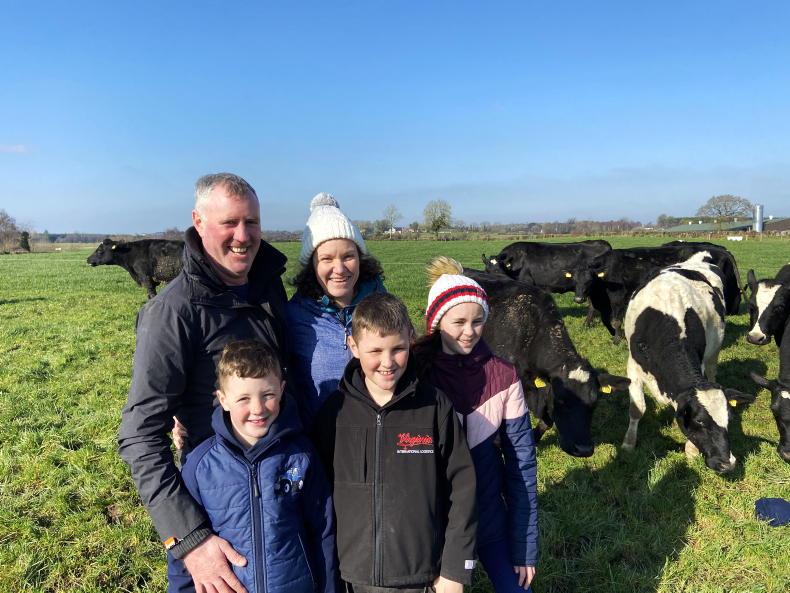
Killian, Madeline, Darragh, Ryan and Chloe Brennan.
This extra land came on stream in early 2020. It needed to be reclaimed, drained, reseeded and have roadways installed at a cost of about €1,000/ac.
A new cubicle shed for 52 cows was built, with a calving area at the back which could be converted to an extra 20 cubicles if needs be.
Four more units were added on to the parlour to bring it to 12 units.
Arguably, the biggest development took place within the herd. The requirement for extra cows presented Killian with an opportunity to improve the herd genetics.
It was killing the profitability of the farm
The existing herd were milky Holstein Friesians with low protein and poor fertility.
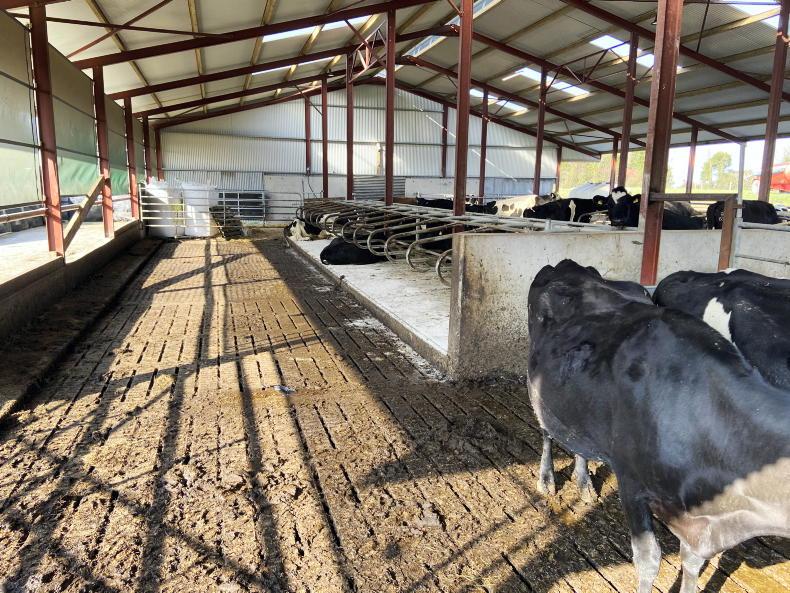
The new cubicle shed has feed space on three sides and holds 52 cubicles with space at the back for 20 more.
“Protein was killing my milk price. I would always be 1c/l below base milk price for the peak months of April, May and June whereas other lads would be getting 5c/l or 6c/l above base price. It was killing the profitability of the farm,” Killian says.
Forty heifers joined the herd in 2020. Twenty-five of these were Jersey crossbred heifers purchased from a good herd in Cork and the remainder were Killian’s homebred heifers, a mix of Jersey crossbred and Holstein Friesian.
These heifers helped to increase cow numbers from 70 in 2019 to 103 for 2020.
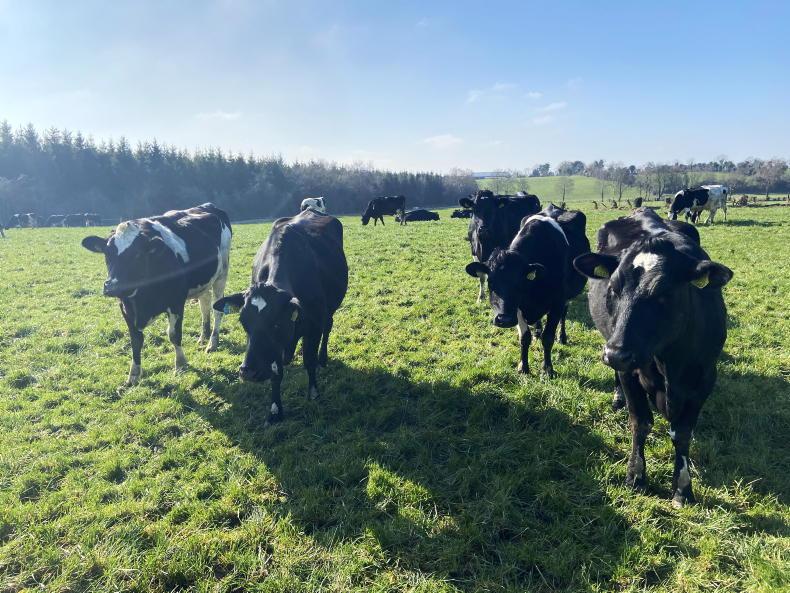
The Brennan's herd grazing the new ground on Monday.
Grass seeds were sown on the new block in May last year and by late June the cows were grazing them. It was only then that the problems started. An outbreak of redwater, caused by the redwater tick, which is present on old pastures and long grass, caused the Brennans grief. In total, 16 cows got redwater. All but two recovered with treatment.
The workload and stress involved in monitoring cows was draining. Killian and Madeline were checking cows late at night for a few weeks during the episode. Two things solved the issue: spreading lime along the base of the hedgerows where they think the tick was and treating cows with pour-on which helped to prevent them from getting it.
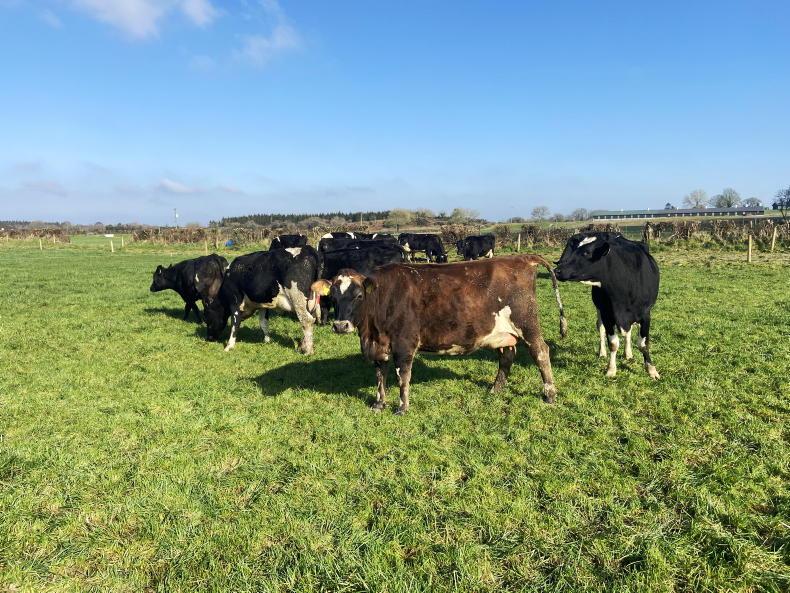
The Brennan's herd grazing the new ground on Monday.
More heifers purchased
More Jersey crossbred heifers were purchased from herds in Tipperary and Laois last autumn. Killian now has 33 maiden heifers with the contract-rearer and the calf shed is bursting with heifer calves, so his days of needing to buy stock are probably behind him.
Last year was the first year that his milk price didn’t drop below base price during the peak months and Killian expects to get above base price this year as last year’s heifers will be that bit older and will contribute more to the bulk tank.
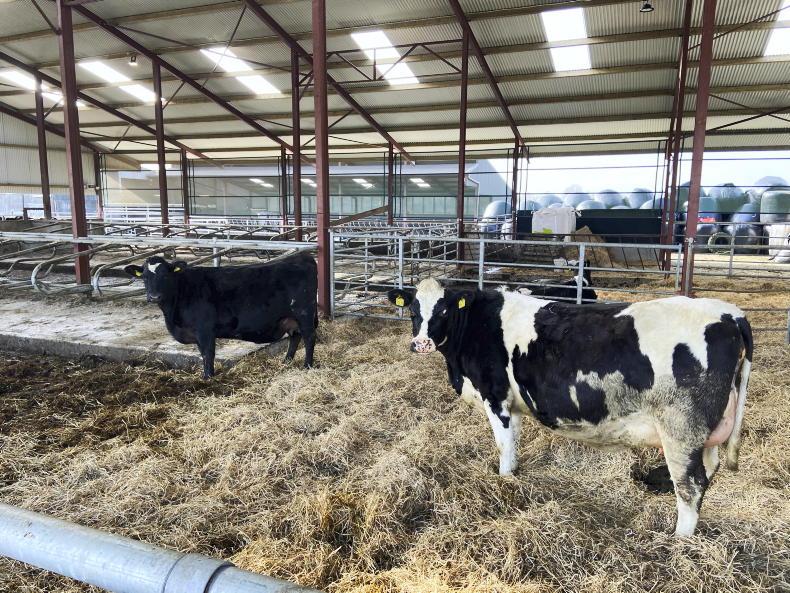
Cows due to calf on the Brennan farm..
Last year’s overall herd performance was very good, selling 482kgMS/cow with 40% first-calvers, albeit from 750kg of meal, and the herd was milked through the winter for the first time in years, to help with cashflow.
It would have taken way too long to breed the quality of the animal I was able to buy in
“I’m very happy with the type of cow I have now. I think it’s the right cow for the system. I remember going for the cows a few times last year during wet weather and the bought-in heifers would be out in the field grazing, while my own cows would be standing at the gap waiting to come in. It would have taken way too long to breed the quality of the animal I was able to buy in.”
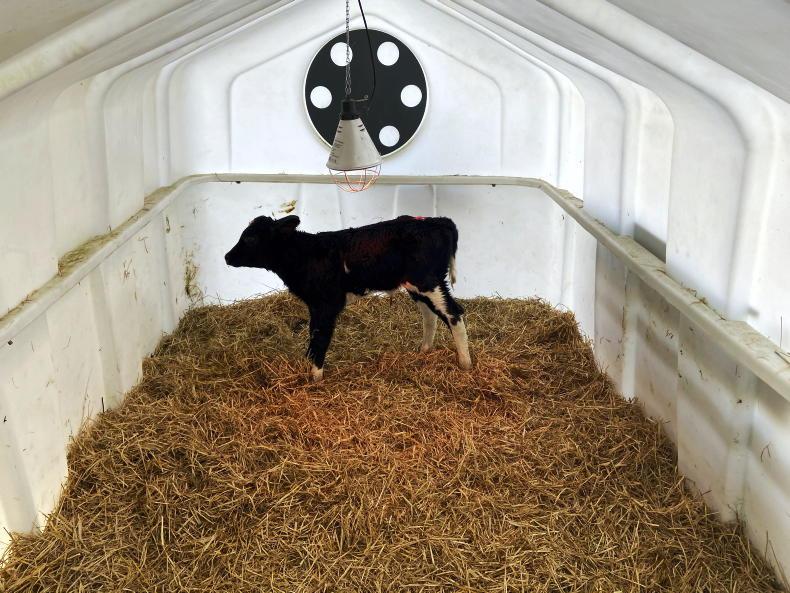
Newborn calves are put in a hutch next to the calving area which has a red lamp.
Killian has his bulls picked out for the upcoming breeding season. The majority of the bulls are Holstein Friesians, with just two sexed semen Jersey bulls to go on Holstein-type cows.
Beef AI will be used on low-yielding and low-EBI cows.
Heifers will be getting two rounds of conventional semen at the contract-rearer’s. Last year was the first time the heifers went to the rearer and Killian says it’s a great work remover, particularly during the breeding season.
Two outside blocks, one 20ac owned block and one 16ac leased block are used for three cuts of silage.
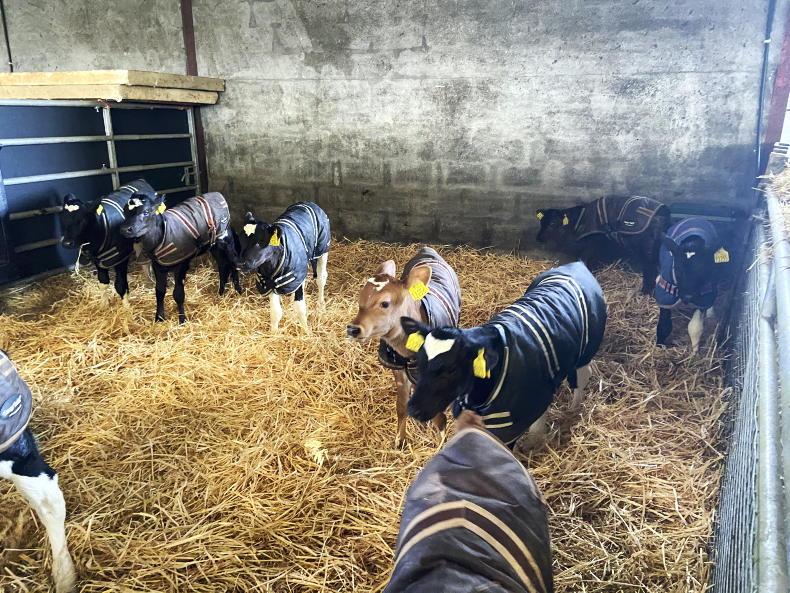
Heifer calves are given jackets which Killian says is a great job.
Just 12ha of the 34.2ha in the milking block are owned, while the rest is leased. The platform is highly stocked at 3.5 cows/ha, but it’s a high-performing block of land, growing almost 15t DM/ha last year. Overall stocking rate is 2.2 cows/ha.
In terms of soil fertility, just 17% of the farm is below target for phosphorus and 4% below target for potash.
Soil pH needs a little bit of work, with 34% below a pH of 6.2. It’s an impressive set of soil sample results and testament to the focus on growing and grazing high-quality grass.
Grass was measured 47 times last year. Killian took up measuring three years ago as part of a grass group set up out of the Ballyhaise research and advisory programme. The guidance of Teagasc advisers James Dunne and Donal Patton is plain to see as you walk around the farm.
At this stage, 72% of the herd has calved, with no losses of cows or calves. Grazing has been sluggish. It was very stop-start up to last weekend, but cows have been out full-time day and night for the past week. By Monday last, Killian had 7ha grazed which is 20% of the farm, while his target was 30% in February.
“I plan to go into some of the wetter parts of the farm over the coming days to get them grazed while conditions are good. I have some peaty fields that get wet but I’m not overly concerned about them. I usually go there in wet weather because while they can get poached they tend to recover well.
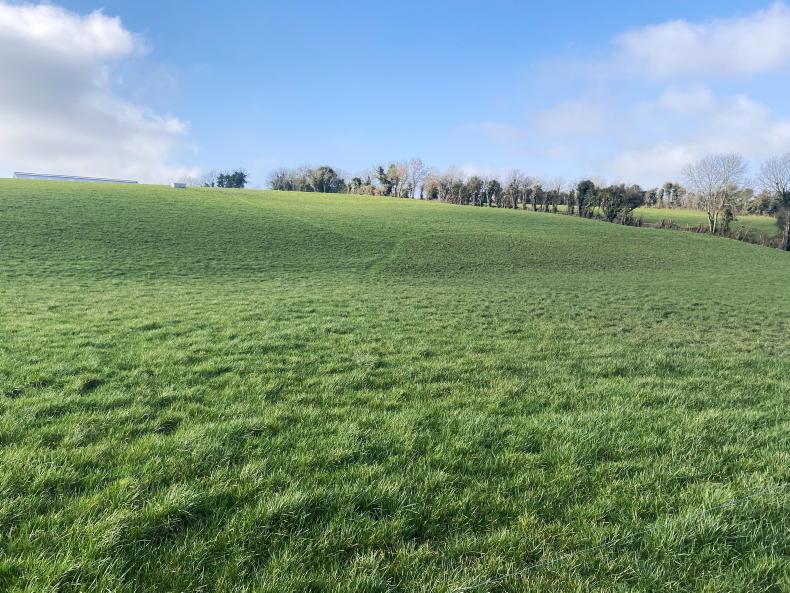
Some damage was done in early spring but it is recovering well.
“At my stocking rate, I’m pretty sure I’ll have to feed silage in March to slow them down a bit, but at the moment I need to get the area grazed increased in order to have grass coming back to start the second round between 10 and 15 April,” Killian says.
Clean-outs on Monday were excellent, with very low residuals and zero damage. The herd is being fed 4kg of 16% protein meal in the parlour and gets access to about 1kg of silage in the collecting yard at milking.
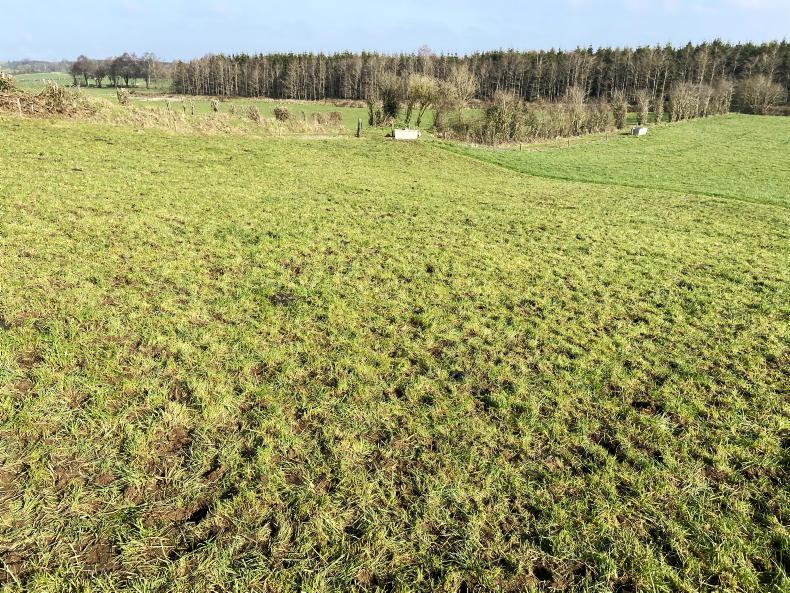
Clean outs were excellent in the field grazed on Monday.
Killian is allocating 7kg of grass morning and evening and uses the grazing calculator on the PastureBase app to determine how much area to give them. Pre-grazing yield is 1,200kg/ha. The herd is in exceptional body condition score for the time of year. Freshly calved cows, particularly first-calvers, can often look raggedy at this time of year, but the Brennan herd was shining in the spring sun this week.
Urea was being spread this week on ground that didn’t get slurry at a rate of 30 units/acre. Fields that got slurry will get 23 units/acre. Twenty per cent of the farm got 2,500 gallons/acre of slurry on 1 February with a dribble bar.
It’s a great job. You can finish up on a Friday evening and get away from the farm until Monday morning
With schools closed due to lockdown, there was extra help on the farm this spring. Chloe, Ryan and Dara all help out with calf feeding and bedding but 90% of calf feeding is done by Killian’s parents.
Madeline works full-time off-farm but helps out morning and evening. A relief milker will do two weekends a month as soon as AI is over. “It’s a great job. You can finish up on a Friday evening and get away from the farm until Monday morning.”
Major changes have taken place on the Brennan farm at Mullaghoran in Co Cavan. Killian Brennan is farming with his wife, Madeline, and parents, Mary and Connie.
The family has just finished a period of expansion and development, with cow numbers increasing from 70 in 2019 to 103 in 2020 and now settling at 120 for 2021.
The catalyst for the increase in numbers was the opportunity to lease 16ha of adjoining land, which brings the milking platform up to 34.2ha.

Killian, Madeline, Darragh, Ryan and Chloe Brennan.
This extra land came on stream in early 2020. It needed to be reclaimed, drained, reseeded and have roadways installed at a cost of about €1,000/ac.
A new cubicle shed for 52 cows was built, with a calving area at the back which could be converted to an extra 20 cubicles if needs be.
Four more units were added on to the parlour to bring it to 12 units.
Arguably, the biggest development took place within the herd. The requirement for extra cows presented Killian with an opportunity to improve the herd genetics.
It was killing the profitability of the farm
The existing herd were milky Holstein Friesians with low protein and poor fertility.

The new cubicle shed has feed space on three sides and holds 52 cubicles with space at the back for 20 more.
“Protein was killing my milk price. I would always be 1c/l below base milk price for the peak months of April, May and June whereas other lads would be getting 5c/l or 6c/l above base price. It was killing the profitability of the farm,” Killian says.
Forty heifers joined the herd in 2020. Twenty-five of these were Jersey crossbred heifers purchased from a good herd in Cork and the remainder were Killian’s homebred heifers, a mix of Jersey crossbred and Holstein Friesian.
These heifers helped to increase cow numbers from 70 in 2019 to 103 for 2020.

The Brennan's herd grazing the new ground on Monday.
Grass seeds were sown on the new block in May last year and by late June the cows were grazing them. It was only then that the problems started. An outbreak of redwater, caused by the redwater tick, which is present on old pastures and long grass, caused the Brennans grief. In total, 16 cows got redwater. All but two recovered with treatment.
The workload and stress involved in monitoring cows was draining. Killian and Madeline were checking cows late at night for a few weeks during the episode. Two things solved the issue: spreading lime along the base of the hedgerows where they think the tick was and treating cows with pour-on which helped to prevent them from getting it.

The Brennan's herd grazing the new ground on Monday.
More heifers purchased
More Jersey crossbred heifers were purchased from herds in Tipperary and Laois last autumn. Killian now has 33 maiden heifers with the contract-rearer and the calf shed is bursting with heifer calves, so his days of needing to buy stock are probably behind him.
Last year was the first year that his milk price didn’t drop below base price during the peak months and Killian expects to get above base price this year as last year’s heifers will be that bit older and will contribute more to the bulk tank.

Cows due to calf on the Brennan farm..
Last year’s overall herd performance was very good, selling 482kgMS/cow with 40% first-calvers, albeit from 750kg of meal, and the herd was milked through the winter for the first time in years, to help with cashflow.
It would have taken way too long to breed the quality of the animal I was able to buy in
“I’m very happy with the type of cow I have now. I think it’s the right cow for the system. I remember going for the cows a few times last year during wet weather and the bought-in heifers would be out in the field grazing, while my own cows would be standing at the gap waiting to come in. It would have taken way too long to breed the quality of the animal I was able to buy in.”

Newborn calves are put in a hutch next to the calving area which has a red lamp.
Killian has his bulls picked out for the upcoming breeding season. The majority of the bulls are Holstein Friesians, with just two sexed semen Jersey bulls to go on Holstein-type cows.
Beef AI will be used on low-yielding and low-EBI cows.
Heifers will be getting two rounds of conventional semen at the contract-rearer’s. Last year was the first time the heifers went to the rearer and Killian says it’s a great work remover, particularly during the breeding season.
Two outside blocks, one 20ac owned block and one 16ac leased block are used for three cuts of silage.

Heifer calves are given jackets which Killian says is a great job.
Just 12ha of the 34.2ha in the milking block are owned, while the rest is leased. The platform is highly stocked at 3.5 cows/ha, but it’s a high-performing block of land, growing almost 15t DM/ha last year. Overall stocking rate is 2.2 cows/ha.
In terms of soil fertility, just 17% of the farm is below target for phosphorus and 4% below target for potash.
Soil pH needs a little bit of work, with 34% below a pH of 6.2. It’s an impressive set of soil sample results and testament to the focus on growing and grazing high-quality grass.
Grass was measured 47 times last year. Killian took up measuring three years ago as part of a grass group set up out of the Ballyhaise research and advisory programme. The guidance of Teagasc advisers James Dunne and Donal Patton is plain to see as you walk around the farm.
At this stage, 72% of the herd has calved, with no losses of cows or calves. Grazing has been sluggish. It was very stop-start up to last weekend, but cows have been out full-time day and night for the past week. By Monday last, Killian had 7ha grazed which is 20% of the farm, while his target was 30% in February.
“I plan to go into some of the wetter parts of the farm over the coming days to get them grazed while conditions are good. I have some peaty fields that get wet but I’m not overly concerned about them. I usually go there in wet weather because while they can get poached they tend to recover well.

Some damage was done in early spring but it is recovering well.
“At my stocking rate, I’m pretty sure I’ll have to feed silage in March to slow them down a bit, but at the moment I need to get the area grazed increased in order to have grass coming back to start the second round between 10 and 15 April,” Killian says.
Clean-outs on Monday were excellent, with very low residuals and zero damage. The herd is being fed 4kg of 16% protein meal in the parlour and gets access to about 1kg of silage in the collecting yard at milking.

Clean outs were excellent in the field grazed on Monday.
Killian is allocating 7kg of grass morning and evening and uses the grazing calculator on the PastureBase app to determine how much area to give them. Pre-grazing yield is 1,200kg/ha. The herd is in exceptional body condition score for the time of year. Freshly calved cows, particularly first-calvers, can often look raggedy at this time of year, but the Brennan herd was shining in the spring sun this week.
Urea was being spread this week on ground that didn’t get slurry at a rate of 30 units/acre. Fields that got slurry will get 23 units/acre. Twenty per cent of the farm got 2,500 gallons/acre of slurry on 1 February with a dribble bar.
It’s a great job. You can finish up on a Friday evening and get away from the farm until Monday morning
With schools closed due to lockdown, there was extra help on the farm this spring. Chloe, Ryan and Dara all help out with calf feeding and bedding but 90% of calf feeding is done by Killian’s parents.
Madeline works full-time off-farm but helps out morning and evening. A relief milker will do two weekends a month as soon as AI is over. “It’s a great job. You can finish up on a Friday evening and get away from the farm until Monday morning.”















 This is a subscriber-only article
This is a subscriber-only article










SHARING OPTIONS: